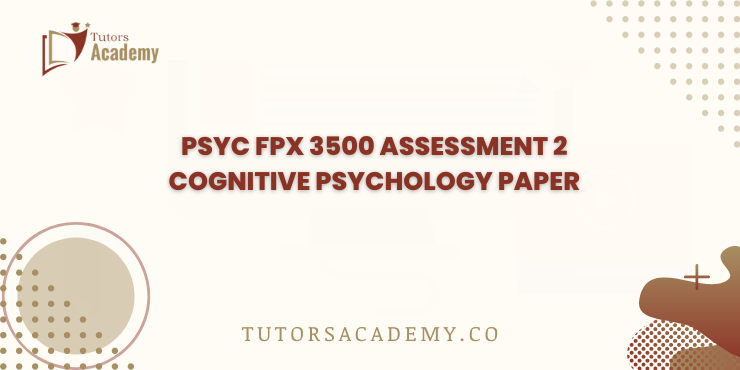
- PSYC FPX 3500 Assessment 2 Cognitive Psychology Paper.
Cognitive Psychology Paper
A cognitive psychology paper is a scholarly work that examines topics related to the mental processes involved in acquiring, processing, and storing information (Schmidt & Mamede, 2020). This cognitive psychology paper reviews three scholarly articles on the concept of learning styles and their applicability in education.
The review assesses the validity and application of theories in the cognitive psychology of learning styles, discusses the implications for teaching practices, and points out any controversies in the effectiveness of these styles in enhancing learning outcomes. Understanding individual learning styles will add value to educational strategies and cognitive development.
Model for Learning Processes Related to Learning Styles
A model that deals with learning processes concerning learning styles is Fleming’s VARK (Visual, Auditory, Read/Write, and Kinesthetic) Model. The VARK model categorizes learners into four primary types based on their sensory preferences for taking in and processing information (Mozaffari et al., 2020).
These are the four learning modalities namely, Visual, Auditory, Read/Write, and Kinesthetic. Auditory learners learn best through lectures, discussions, and the use of music or sound. Auditory learners learn well when they are given explanations or discussions in the form of audio. Read/Write learners prefer writing such as reading books or taking notes while Kinesthetic learners learn better when they are moving around.
PSYC FPX 3500 Assessment 2 Cognitive Psychology Paper
The model postulates that people have a preferred learning style, but they may use more than one style depending on the situation. Knowledge of these preferences may be useful to educators to improve teaching strategies to improve learning outcomes. VARK also focuses on how the instructional strategies should be matched with the learning modality to increase the learning outcomes.
The main intention of the VARK model in education is to allow a more personalized type of approach. This, in turn, can bring about effective teaching since tutors are adapting their methods to suit different learners. While learning styles are highly influential, they have been criticized (Adel Mohamed Aboregela, 2023). Some researchers claim that learning styles are not as fixed as the model suggests. They argue that all learners may benefit from a variety of teaching methods, rather than just using their preferred style.
Examples of How a Model Impacts Learning
The study conducted by Boysen Guy A, (2024) talks about the Universal Design for Learning (UDL) approach. The UDL model, similar to VARK, encourages differentiation of the instruction based on students’ learning modalities, such as visual, auditory, read/write, and kinesthetic, to improve learning.
But, according to the study, there is no evidence that instruction based on learning styles enhances academic achievement. Some of the issues that are leveled against VARK and UDL include the fact that they are based on generalization and have little empirical evidence. These approaches are learner-centered and must change to more general principles that are research-based for all students as opposed to learning styles.
In the study conducted by Kamal et al., (2021), the VARK assessment was used to assess the learning styles of 137 healthcare students, and it was discovered that 86% of the students are multimodal learners. 8% chose an unimodal learning style preference while 32% preferred visual and 26% preferred reading. Only 13. 2% preferred a multimodal approach. Learning styles were not found to be related to student’s academic performance in any way. In connection with the VARK model, this work reveals that students have specific tendencies, and the visual and reading modes are the most popular ones.
The VARK model affects learning by making educators aware of the different preferences and thus making them adjust for the same. However, the non-significant relationship between learning styles and academic achievement as revealed in this study implies that matching the teaching strategies to the VARK may not necessarily improve students’ performance. This goes a long way in supporting criticism that learning style models alone are inadequate for academic achievement.
The study presented by (Rinekso, 2021) explores the learning styles theory which postulates that the process of teaching is more effective when the teaching strategies are congruent with the students’ learning styles. Although the theory is widely used by teachers of English as a foreign language, new studies question the theory arguing that it is full of myths and misconceptions. The study suggests that instead of concentrating on learning styles, teachers should pay attention to the background knowledge, needs, interests, and independence of students in addition to using interesting materials.
The VARK model affects learning in a way that divides students into different sensory modalities: visual, auditory, read/write, and kinesthetic. This model leads the teachers to adopt these preferences in their teaching process. Nevertheless, the critique of the study corresponds with the research that reveals that VARK may not enhance learning outcomes to a great extent. This has shifted focus from teachers to adopt more of the learning style models and focus on the general well-being of the students.
Research Methods Used in the Cited Sources
Boysen (2024) indicated that the Universal Design for Learning (UDL) is an effective option for enhancing learning. The method used in the reason is experimental to assess the efficacy of the UDL approach in two groups. The UDL focuses on designing the educational curriculum to increase the student’s management and learning. One group stated that UDL is useful for students with disability accommodations. However, the other group stated that the UDL approach can be used to improve learning in all students. The experimental design used in the study showed that UDL improved learning in diverse groups of students.
Kamal et al. (2021) evaluated the learning styles of healthcare students by using the cross-sectional research design. The authors collected data from 137 healthcare students to assess the improvement of learning approaches. The cross-sectional study focused on collecting data from healthcare students through a self-administered questionnaire regarding visual, aural/auditory, read/write, and kinesthetic (VARK) assessment. The findings of the study indicated that 86.8% of respondents selected the unimodal approach as the best learning style. However, 13.2% preferred the multimodal approach as the best method of learning.
Rinekso (2021) used the qualitative design to explore the pros and cons of the learning methods. The research design helped in collecting insights about the benefits and drawbacks of the learning styles. The participants selected for the study were English language teachers that employed learning styles theirs in the teaching practice. The qualitative analysis of the data indicated that using diverse learning styles methods helped in improving student’s engagement and learning,
The research methods used in the three sources are appropriate for the selected study. For instance, the first study assessed the impact of UDL in two groups using experimental methods. The second study assessed the healthcare student approaches to leading through a cross-sectional study. The third study used the qualitative design to explore the English teacher experience regarding learning styles. All the sources are appropriate as the authors provided comprehensive insight into the effectiveness of different learning styles.
Strengths and Limitations of the Model
The VARK model of learners provides strengths of simplicity and practical application: visual, auditory, read/write, and kinesthetic. It collates information on how instructors can understand and accept variations in learning styles and make changes in instructional delivery methods, which may enhance learning and engagement (Mozaffari et al., 2020). Using the practice methods that best suit the learning style, such as visual for visual learners and discussion for auditory learners, the VARK model offers simplicity for how individual learning styles are to be addressed.
Its major limitations concern the fact that research has failed to show how hitching teaching methods to learning styles improves academic results. This leads to a question of its effectiveness since it cannot differentiate between learners in complex ways (Adel Mohamed Aboregela, 2023). With all these disadvantages, the VARK model is still useful when combined with other evidence-based strategies such as active learning and varied instructional techniques toward a holistic approach to education.
Conclusion
VARK model categorizes learners into four types: Visual, Auditory, Reading/Writing, and Kinesthetic. The framework allows educators to provide different teaching strategies based on different learning preferences. Although its simplicity allows for several varied teaching methods that may arguably enhance the learning experience, there are significant limitations with the model, not least a substantial lack of empirical data linking learning styles to improved academic performance.
Besides, such inflexible categorization of this model highlights specific complexities in individual learning processes. The VARK model, therefore, is helpful in educational strategies but does need supplementation with evidence-based practices for more flexibility and responsiveness toward capturing a learning environment that caters to every student’s diverse needs. Read more about our sample PSYC FPX 3500 Assessment 1 Popular Versus Scholarly Sources for complete information about this class.
References
Adel Mohamed Aboregela. (2023). Learning style preference and the academic achievements of medical students in an integrated curriculum. PubMed, 16(12), 1802–1807.
https://doi.org/10.25122/jml-2023-0366
Boysen Guy A. (2024). Lessons (not) learned: The troubling similarities between learning styles and universal learning design. Psycnet.apa.org.
https://psycnet.apa.org/record/2021-57881-001
Kamal, I., Abdul Karim, M. K., Awang Kechik, M. M., Ni, X., & Abdul Razak, H. R. (2021). Evaluation of healthcare science student learning styles based on VARK analysis technique. International Journal of Evaluation and Research in Education (IJERE), 10(1), 255.
https://doi.org/10.11591/ijere.v10i1.20718
Mozaffari, H. R., Janatolmakan, M., Sharifi, R., Ghandinejad, F., Andayeshgar, B., & Khatony, A. (2020). The relationship between the VARK learning styles and academic achievement in dental students. Advances in Medical Education and Practice, Volume 11(11), 15–19.
https://doi.org/10.2147/amep.s235002
Rinekso, A. (2021). Pros and cons of learning style: An implication for English language teachers. Journal of English Language Pedagogy Literature, and Culture, 6(1), 2021.
https://doi.org/10.35974/acuity.v6i1.2396
Schmidt, H. G., & Mamede, S. (2020). How cognitive psychology changed the face of medical education research. Advances in Health Sciences Education, 25(5), 1025–1043.
